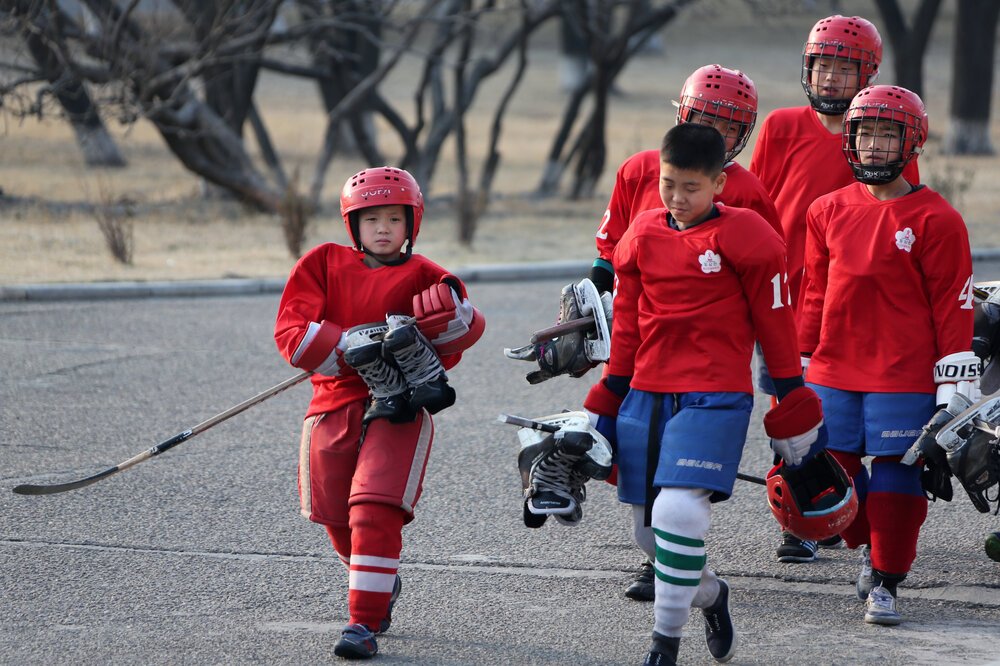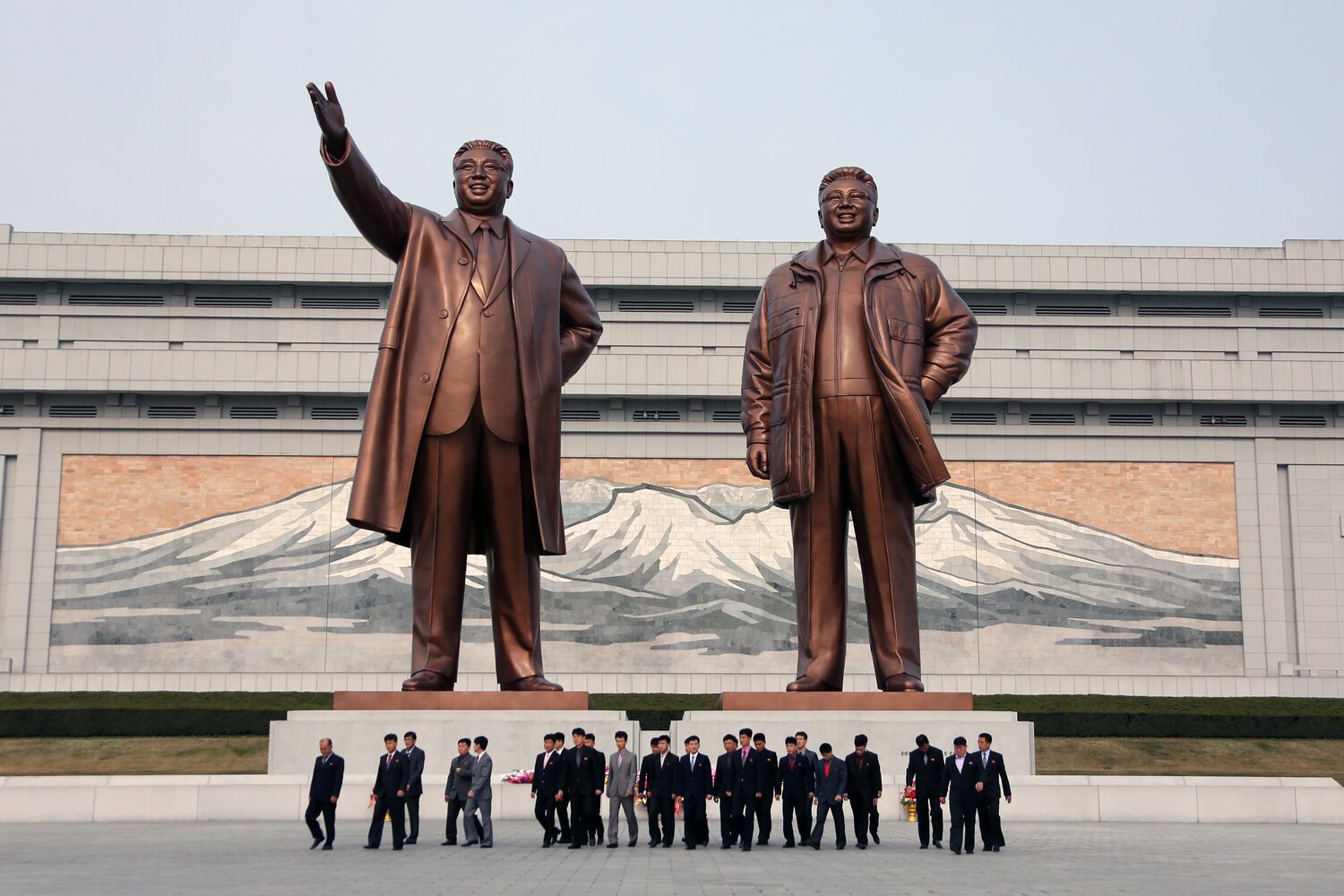These Photos Take You Inside North Korea's Ice Hockey League
A SURPRISING HISTORY LESSON
You may be surprised to learn that hockey exists in North Korea. Not only does it exist, but there are also over 1,200 players in the country at all levels and it’s been around since the Korean War.
First popularized by Soviet and Chinese soldiers in the 1940s and 1950s, ice hockey is actually a well-known, albeit not very popular, sport in North Korea. There are eleven professional hockey clubs in the country today (six men's teams and five women's teams), along with numerous provincial and youth teams. North Korea’s traditional hockey towns include Pyongyang, Kanggye, Hyesan and Samjiyon.
Founded in 1955, the Korean Ice Hockey Association (KIHA) is the governing body for hockey in North Korea; they are responsible for recruiting players from across the country, operating the children's and youth leagues as well as organizing tournaments and facilitating the overseas participation of the DPRK National Teams. The KIHA officially joined the International Ice Hockey Federation (IIHF) in 1963 and has been regularly participating in IIHF tournaments throughout the 2000s.
North Korea’s official winter sports club is called Taesongsan and they have hockey and winter sports training facilities in Pyongyang city. Other local hockey club teams are run by different departments, including the DPRK Fisheries Department and the Pyongyang Railway Bureau. They compete in five domestic round-robin tournaments a year. Additionally the men’s and women’s national teams travel abroad annually for the IIHF tournaments in March and April.
A goalie from the Taesongsan Club team listens to his coach’s post game lecture in their changing room at Pyongyang’s Ice Arena alongside his teammates. The team won their match against the Susansong team— run by the DPRK Fisheries Department.
Players from the DPRK Women’s National Team do stretches outside the Ice Arena in central Pyongyang. The national women’s team is ranked above the men’s, and they earned a bit of fame on the world stage when five of their squad joined the South Korean Women’s National Team in Pyeongchang, South Korea to compete together in the 2018 Winter Olympic Games.
Pyongyang’s littlest grommet— his helmet is several sizes too big, as are his skates, gloves and stick, but his attitude was certainly not diminished at all.
North Korea’s youth hockey league is an active presence at the Ice Arena several days a week run by the Taesongsan Sports Club. The players are mostly young recruits from the athletic schools around the city and countryside towns in the north of the country; some of them will go on to play on local club teams and maybe even for the country’s national team.
Players from the DPRK Men’s National Team practice before their upcoming overseas tournament. Every year the DPRK men’s and women’s teams travel abroad to participate in their IIHF division round-robin tournaments. In 2017 the men travelled to Mexico where they placed second to last in the Division II B tournament.
As the team is not able to transit through North America due to sanctions, they had to take the train to Beijing and fly from there to Amsterdam and then onwards to Mexico City in order to participate in the tournament.
Hockey practice is not all on the ice or in the gym. Members of the Women’s National Team practice stretches and training drills outside Pyongyang’s Ice Arena. Notice some of the girls in the blue jackets in the back? Those are 2018 Pyeongchang Olympic Jackets from the DPRK Olympic Committee, as they played on the mixed North-South women’s team.
In this photo you can see the full outside of the Pyongyang Ice Rink. Built in 1982 along Pyongyang’s Taedong River, it is the largest ice rink in the country and hosts the annual Paektusan Prize Figure Skating festival, which attracts foreign competitors from Asia, Russia and Eastern Europe, in addition to North Korea’s domestic ice hockey tournaments. It may have been modelled off the 1970 Cathedral of Brasilia in Brazil, as the architectural designs are noticeably similar.
In this hockey card type photo, one of the youngest female goalie recruits poses for the camera inside Pyongyang’s Ice Arena after a late night goalie practice. The rink is constantly busy— between hockey practices, figure skating, speed skating, and games, everyone wants a piece of ice time. Typically, practices may go on past 8 or 9pm and start up again around 8am.
Pyongyang only has one proper hockey rink in addition to one public skating centre. Other hockey rinks may be found in Kanggye, Hyesan and Samjiyon in the northern part of the country.
Members of the Taesongsan Sports Club conduct weight training inside their club facilities in the outskirts of Pyongyang city. Taesongsan is the only dedicated winter sports club in the country and they train athletes in hockey, figure skating, speed skating, alpine skiing, and downhill skiing.
A visit to their club house is extremely rare, as foreigners have never before been granted access to the facilities. Many of the out of town recruits sleep in the dormitories here and have their meals in the club canteen.
After the last game of the Tournament of the Republic, one of five annual domestic hockey club tournaments in the DPRK, the Taesongsan team (red) and Pyongchol team (while) stand and bow for the crowd of spectators (all seated behind the photographer, numbering around 100 people in total). The Taesongsan team won the game, leading to their third straight title in this annual tournament.
In January, officials from the KIHA select players from all three professional men’s club teams to form the DPRK National Team. From mid-January through the IIHF tournament, drafted National Team players practice together while their club teams move to the northern city of Samjiyon to play on without them.
With skates and sticks in hand, youth players walk from the parking lot towards Pyongyang’s ice rink for their afternoon practice. Their coaches are former National Team and club team members who retired into coaching. Much of their gear does not fit properly, since it’s difficult to get small sized gear in North Korea and all of the equipment is handed down from former youth players.
The gear mostly belongs to the sports club, not the players themselves, but those with wealthier families may be able to afford their own skates.
Every year the DPRK National Team players travel overseas to participate in the IIHF tournament. As full members, most of their travel costs are subsidized by the IIHF in Switzerland, as they seek to encourage more countries to play hockey. Here, a player from the men’s team poses with his wife and daughter on the platform at Pyongyang Railway Station. Because the IIHF cannot subsidize travel directly out of North Korea, the hockey team takes the 23-hour train from Pyongyang to Beijing to save on costs.
As it’s a great honour to represent the country in international competition, many of the players’ families send them off from Pyongyang Railway Station. It’s a joyous occasion for the family members, as they chat on the platform and watch their loved ones depart to the waves and well-wishes of officials from the Ministry of Sport and KIHA.
The DPRK Women’s National Team listens to their coach during an on-ice practice in Pyongyang. As the women’s team is ranked higher than the men’s, the KIHA places greater emphasis on their training— offering them better resources and talent.
The women’s squad works incredibly well together on the ice and keeps a disciplined and friendly attitude. They are always laughing and playing around with each other between practices, but when on the ice they are ultra focused.
As a courtesy to the State and for good luck, every North Korean sports team visits the Mansudae Grand Monuments in Pyongyang to lay flowers and bow in front of the bronze statues of leaders Kim Il Sung and Kim Jong Il before departing the country to compete internationally. This action is a serious ritual in the DPRK and formal attire is required, as many North Koreans see visiting the statues as a way of “meeting” and honouring the country’s leaders.
The Men’s National Team pictured above visited the statues on the early morning before their departure to New Zealand. In order to pay their respects at the statues, they have to apply through an internal department and schedule a time to visit, as unplanned visits are not permitted.
The total visit time lasted under five minutes. They then quickly hurried onto their team bus to drive a short distance to Pyongyang Railway Station, where they immediately changed into their official track suits and loaded their hockey bags onto the international train to Beijing.
While hockey may not be the most popular sport in North Korea, there are some eager fans who attend the games, many of them are family members of the players, former athletes, retirees, or fellow athletic students or sports club members.
Here, the coach for the Pyongchol club team stands by the bench while players watch on. Their team would go on to lose this final match against their main rivals— the better equipped Taesongsan club.
Players from the Women’s National Team stand in attention outside while learning a new training drill. They are more focused than the men’s team and generally work better on and off the ice together.
In this photo, players from the youth team are about to practice rolling drills on the ice. The age range for children’s and youth league players ranges from 8 years old to 17 years old. After then, they are either picked up by a club or university team, or must find their way in an educational or career path outside of hockey.
North Korea’s two main club rivals— the Taesongsan Club and the Pyongchol Club— battle it out on the ice during a game. The Taesongsan Club is a specialty organization for the development and training of winter sports, and the Pyongchol club is run by the Pyongyang Railways Department, a historic hockey club in the city.
The two clubs are typical rivals, but since the National Team combines members from both clubs along with the Susansong club, many of them have worked together as teammates and know each other well.
From mid-January through April, the National Team forms a singular unit and practices together until the season restarts in September.
With laughter and determination, the women’s team play a relay race using medicine balls outside the ice rink in central Pyongyang. Their attitude is unmatched.


















